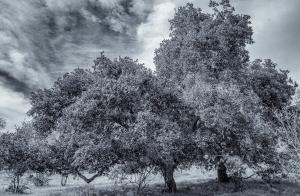20% off all products! Sale ends tonight at midnight EST.
October 4th, 2017 - 03:12 PM

Coast live oak occurs in the coast ranges from north central California southward to northern Baja California. A picturesque, broad-canopied, evergreen oak, 20-50 ft. high and wide. Old trees can reach 100 ft. Thick, slightly glossy, gray-green leaves are oval and holly-like. Evergreen tree with short, stout trunk; many large, crooked, spreading branches; and broad, rounded crown; sometimes shrubby.
This is the common oak of the California coast and foothills, forming parklike groves that often appear in the scenery of motion pictures made in Hollywood. The lower limbs of ungrazed trees often recline on the ground. Mature bark is gray and shallowly furrowed. Leaves are oblong to oval, 2 to 6 cm in length, cupped, with entire to toothed margins. The upper surface is strongly convex, deep green and smooth, but the lower surface is paler, with hairy-tufted vein axils. Like all oaks, coast live oak is monoecious and wind pollinated. Acorn cups are composed of thin, flat scales.
The one-seeded nuts are 2 to 4 cm long, narrowly conical, and mature in one year. On average, trees have high acorn production once every 2 to 3 years. Flowering takes place from February to April. Fruits mature between August and October.
Coast live oak is the only California native oak that actually thrives in the coastal environment, although it is rare on the immediate shore; it enjoys the mild winter and summer climate afforded by ocean proximity, and it is somewhat tolerant of aerosol-borne sea salt. The coastal fog supplies relief from the rainless California summer heat.
It is the dominant overstory plant of the coast live oak woodland habitat, often joined by California bay laurel and California buckeye north of Big Sur. Associated understory plants include toyon, various manzanitas and western poison-oak.
Normally the tree is found on well drained soils of coastal hills and plains, often near year round or perennial streams. It may be found in several natural communities including coast live oak woodland, Engelmann oak woodland, valley oak woodland and both northern and southern mixed evergreen forests. While normally found within 100 kilometers (62 miles) of the Pacific Ocean at elevations less than 700 meters (2,300 feet), in southern California it occasionally occurs at up to 1,500 meters (4,900 feet) in altitude.
The California oak moth (Phryganidia californica) caterpillar subsists entirely on living and fallen leaves of the Coast Live Oak. In 8-10 year cycles, the caterpillar will appear in sufficient abundance to denude healthy trees. The trees recover, and botanists speculate that the species provide mutual benefit, possibly in the form of fertilizer for the oak. The coast live oak is also the only known foodplant of Chionodes vanduzeei caterpillars.
Comments
There are no comments on this blog. Click here to post the first comment.